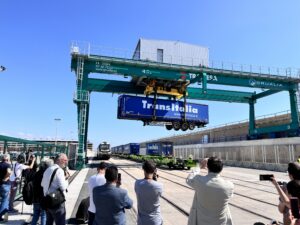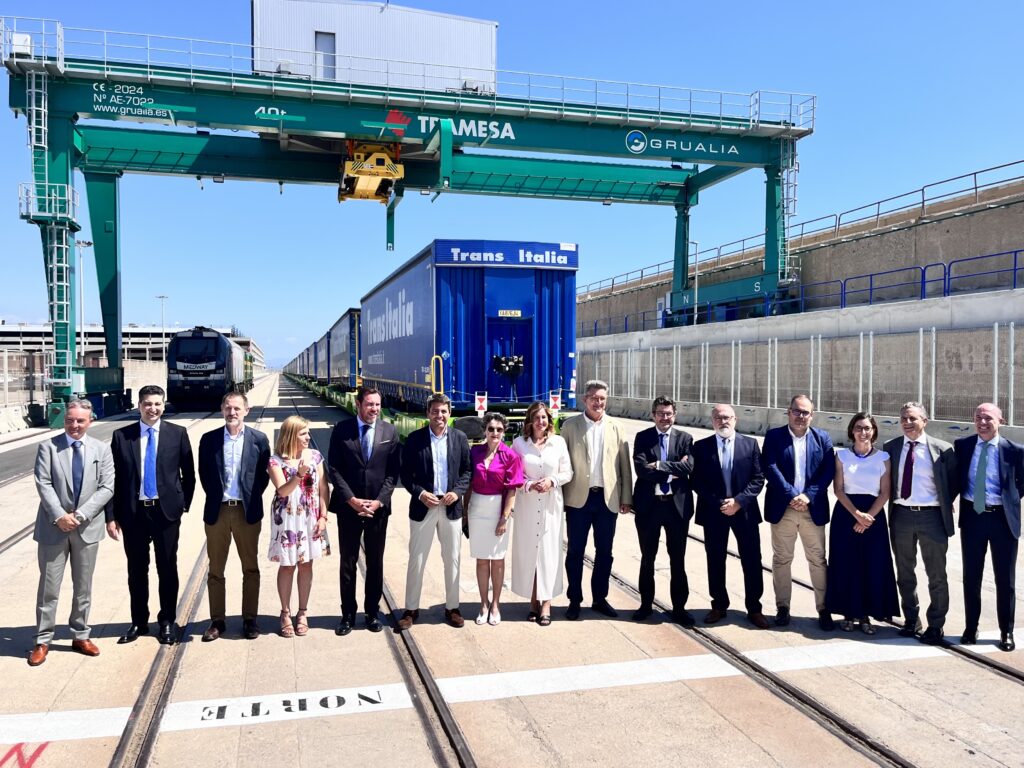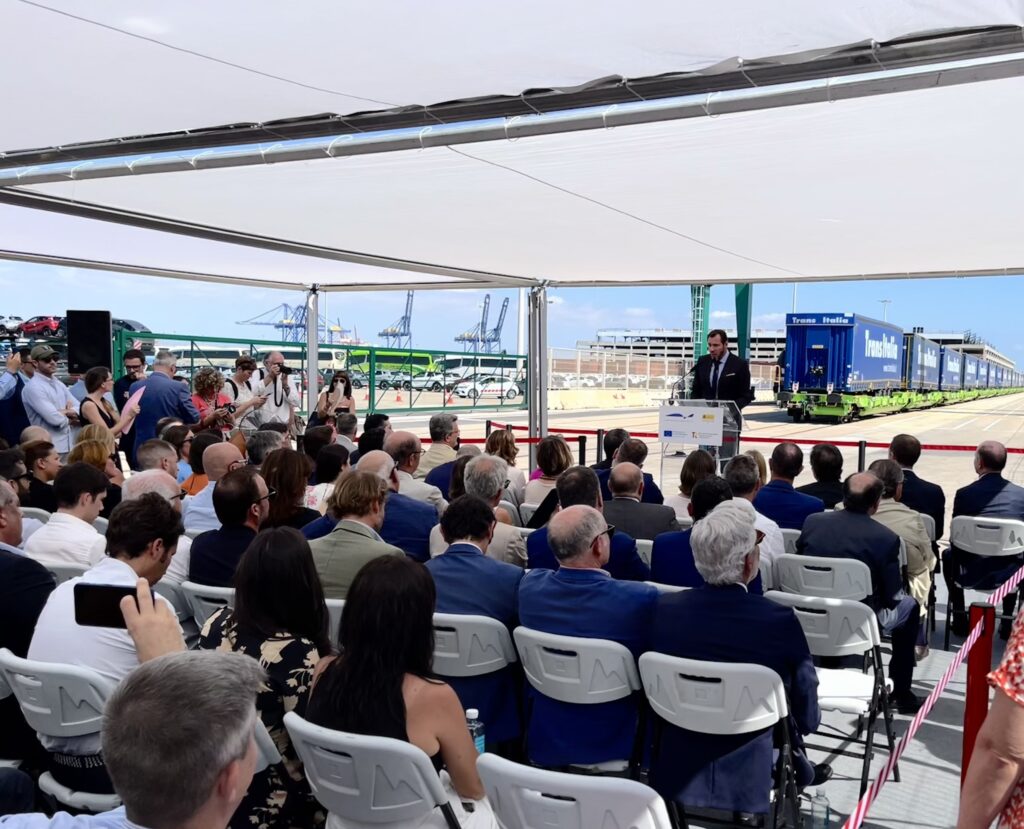
- The new combined transport terminal at the Port of València is already in operation, allowing lorry semi-trailers to be loaded and unloaded between the road and the railway track
- The first railway motorway on the Peninsula allows lorry trailers to travel from Italy to Madrid – and vice versa – by changing at the Valencian port area, thus saving 16,000 tonnes/year of CO2 emissions into the atmosphere
- The new infrastructure has meant a global investment of 20 million Euro, of which the PAV contributes with more than 3.7 million Euro and will allow more than 10,000 lorries to board the railway every year
- The fact that one of the gateways to the railway motorway is the Port of Valencia makes possible the connection with the maritime motorways that link Valencia with the Mediterranean ports
- The PAV has a strategy to improve its rail infrastructures – more connections and more trains – with a planned investment of 240 million euros

On the occasion of the commissioning of the new combined transport terminal at the Port of València – capable of loading and unloading lorry semi-trailers between road and rail – the Port Authority of València (PAV) today invited authorities and members of the port community to see the operation in situ.
This new terminal facilitates the operation of the first railway motorway on the Peninsula as it allows lorries to travel between Madrid and Valencia on board the train, thus saving CO2 emissions into the atmosphere. In fact, according to the certified calculation of emissions in accordance with the ISO 14064-2 standard, the reduction of greenhouse gases per semi-trailer on the Valencia-Madrid route is 85%.
The event was attended by Mar Chao, President of the PAV; Oscar Puente, Minister of Transport and Sustainable Mobility; Carlos Mazón, President of the Generalitat Valenciana; María José Catalá, Mayor of València; Jesús Calvo, CEO of Tramesa and Luigi D’Auria, CEO of TransItalia. As guests, Álvaro Rodriguez Dapena, President of Puertos del Estado; Ángel Contreras, President of Adif; representatives of the Spanish Government and the Generalitat Valenciana and the members of the Board of Directors of the Port Authority of València, including the mayors of València and Sagunto. Also present were representatives of the companies that have participated in the implementation of the project and numerous entrepreneurs from the sector.
According to Mar Chao, ‘an idea has become a reality: lorries are getting on the train’. Thanks to the teamwork of the PAV, Puertos del Estado, the Government, Adif, Grimaldi, Tramesa, TransItalia… this project is now a reality. The shared success of many’. ‘The perfect alignment of all the authorities and private support have made it possible. Today we are launching the first rail motorway connecting with Madrid, but we will reach Lisbon. The Port of València continues to work towards its goal of providing the best service’.
Jesús Calvo and Luigi D’Auria spoke along the same lines, insisting on the idea of the success of public-private collaboration and on the goal of decarbonisation, an objective shared by all. Connectivity, efficiency, innovation and safety are also the main characteristics of this initiative. A terrestrial railway reality that is ready to connect with the maritime motorways and ro-ro routes that link Valencia with the most important ports in the Mediterranean.
For her part, María José Catalá, faced with an essentially ecological project, insisted that ‘the Port of València is on the right path, the path of prosperity and sustainability, committed to a public-private strategy and to decarbonisation. València is an example that progress can go hand in hand with sustainability’.
Following the mayoress, Óscar Puente stated that this motorway will attract 10,000 lorries per year. This means a saving of 7 million euros in the effects of pollution, noise and other associated consequences. Specifically, it will mean avoiding a total of 16,000 tonnes of CO2 in the atmosphere’.
Carlos Mazón assured that the Valencian Region has once again shown that ‘it is a pioneer in sustainable mobility with the launching of the first railway motorway in Spain’. Likewise, he highlighted the Port of Valencia’s commitment to ‘increase the use of the railway in its facilities to reduce emissions and fight against climate change’ and stressed that the ‘future of logistics, which is so important for our industry, depends on this kind of initiatives’.
Technical characteristics and investment
With the start-up of the new terminal, developed on the existing track beaches in the East dock of the Port of València, the port facilities have been provided with the necessary infrastructure – so that operators can opt for the operation of this service, under free competition – to carry out the transfer of cargo between road-rail modes of transport.
The area where it operates is located right next to the breakwater, in the area occupied by the railway and the access road to the southern end of the dock, which covers approximately 740 metres. The civil works consisted of the foundations of the two rails on which the gantry crane moves for loading and unloading operations of semi-trailers from the rail motorway, as well as the installations associated with the implementation of the gantry crane.
The new infrastructure has involved an overall investment of 20 million euros, which has been paid for by Valenciaport, Adif, TransItalia and Tramesa, as well as other collaborating companies. The PAV invested more than 3.7 million uros in the work carried out by Pavasal, the main features of which are as follows:
- 1,482 metres of beam-rail type foundations for gantry crane
- 1,476 metres of A100 type rail for the gantry crane runway
- 2,940 cubic metres of concrete in the rail foundations
- 780 metres of reversible rail with traffic control and management system
- Lighting system consisting of 38 81W luminaires
- Low-voltage electrical supply for 150 kW gantry crane power
- 7,500 metres of supply and installation of single-pole cable
- 880 metres of perimeter enclosure of the track yard.
TransItalia and Tramesa have also invested heavily in this project, specifically in the installation of the gantry crane and the necessary equipment for its operation. The Italian company has taken on the purchase of specific lorry semi-trailers, while the Spanish operator has done the same with specific wagons for this operation, while it has also taken on the purchase of the gantry crane that already operates at the East dock terminal of the port of Valencia to couple or uncouple these trailers to the rail convoys.
TransItalia handles 70,000 lorries per year on Spanish soil that originate in and/or are destined for Italy and Greece. In its connections with these countries, TransItalia works in most cases with the Grimaldi shipping company. Thus, through this shipping company it covers all destinations in the country and works mainly in the ports of Salerno, Savona and Livorno – in Italy – and in Greece it does so through the ports (mainly) of Piraeus and Atraso.
The fact that one of the gateways to the rail motorway is the Port of València makes it possible to connect with the maritime motorways that link Valencia with the ports of the Mediterranean. This project is financed by the European Union’s Next Generation funds and the Spanish Government’s Recovery, Transformation and Resilience Plan. A further 20 million investment is also planned to extend this motorway to Portugal.


